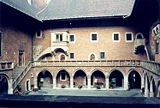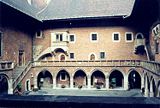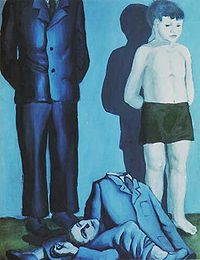
Andrzej Wróblewski
Encyclopedia
Andrzej Wróblewski was a Polish
painter
who died in a mountaineering
accident in 1957 when he was only 29. He is recognized by many as one of Poland's most prominent artists in the early post World War II
era, creating an individualistic approach to figurative
painting
.

; his mother introduced him to the art of woodcut
which he practiced from 1944 to 1946. Immediately after the Second World War
his family moved from Wilno to Kraków
, where he passed the matura
exams and became a student in the Painting and Sculpture Department of Poland's oldest art school, the Academy of Fine Arts, where he studied between 1945 and 1952 under Zygmunt Radnicki, Zbigniew Pronaszko, Hanna Rudzka-Cybisowa and Jerzy Fedkowicz. Also between 1945 and 1948 he simultaneously studied art history at the Jagiellonian University
, Poland's oldest university (and one of the oldest in the world).
style propagated in academic circles in Poland
during this period and at the 1st Exhibition of Modern Art at Kraków
in 1948 he was recognized as a painter exhibiting some original spatial forms. It was important to Wróblewski to indulge in art work that was contrary to popular techniques and style in Poland at the time creating a Self-Teaching Art School as a unit of the Association of Polish Academic Youth at the Kraków Academy of Fine Arts for young inspired painters. Its first members included painters such as Przemysław Brykalski, Andrzej Strumillo, and Andrzej Wajda
. This was the first group in the history of Polish art to openly manifest against the aesthetics
of colorism
. The primary thesis of Wróblewski's program accented the need for art in which "aesthetic and ideological elements would be indivisibly fused."
Between 1947 and 1948 Wroblewski focused on experimentation in oil paintings and gouaches developing a unique means of expression, whilst remaining open to the influences of modern artist styles such as surrealism
, abstract art
, and geometric art), which in turn affected the nature of other talented artists in Kraków
. His canvasses of this period frequently include geometric figures Niebo nad Gorami (The Sky over the Mountains), Niebo Niebieskie (Blue Blue Sky) in 1948; Segmenty, (1949).
 Through exploration in art Wroblewski devised his own formal style, with his own artistic interpretation, revealed in one of his most famous works Executions dating from the late 1940s illustrating his heightened expressiveness and metaphorical abilities depicting real life events. These paintings depicting brutal events during the German occupation of Poland are exceptional for the intensity of feeling they provoke. The artist accomplishes this by depicting brutally deformed human figures torn into pieces; at the same time the canvasses are maintained in cold, blue-green, cadaver-like hues.
Through exploration in art Wroblewski devised his own formal style, with his own artistic interpretation, revealed in one of his most famous works Executions dating from the late 1940s illustrating his heightened expressiveness and metaphorical abilities depicting real life events. These paintings depicting brutal events during the German occupation of Poland are exceptional for the intensity of feeling they provoke. The artist accomplishes this by depicting brutally deformed human figures torn into pieces; at the same time the canvasses are maintained in cold, blue-green, cadaver-like hues.
He was also highly interested in art theoretician and literature
critique at times, since 1948 publishing articles in Głos Plastyków ("Artists' Voice"), Przegląd Artystyczny ("Arts Review"), Twórczość
("Creativity"), Gazeta Krakowska
(Kraków's Newspaper) and Życie Literackie ("Literary Life").
Wróblewski adopted the state-favoured style of socrealism. After death of Stalin and resulting destalinization lessened governmental pressures on various spheres of life, art included, from 1955 he reverted to his previous interests creating a series of figurative paintings centering on the subject of the family. Generally positive in mood, they were inspired by the artist's private life was notably by the birth of his son Andrzej in 1954).
Wroblewski died in a mountaineering accident in Tatry on 23 March 1957. He was the author of over 150 oil painting
s, 1400 drawings, dozens of other art forms and over 80 published articles. His works are featured in the collections of many Polish museum
s and exhibition
s.
gjd
Poland
Poland , officially the Republic of Poland , is a country in Central Europe bordered by Germany to the west; the Czech Republic and Slovakia to the south; Ukraine, Belarus and Lithuania to the east; and the Baltic Sea and Kaliningrad Oblast, a Russian exclave, to the north...
painter
Painting
Painting is the practice of applying paint, pigment, color or other medium to a surface . The application of the medium is commonly applied to the base with a brush but other objects can be used. In art, the term painting describes both the act and the result of the action. However, painting is...
who died in a mountaineering
Mountaineering
Mountaineering or mountain climbing is the sport, hobby or profession of hiking, skiing, and climbing mountains. While mountaineering began as attempts to reach the highest point of unclimbed mountains it has branched into specialisations that address different aspects of the mountain and consists...
accident in 1957 when he was only 29. He is recognized by many as one of Poland's most prominent artists in the early post World War II
World War II
World War II, or the Second World War , was a global conflict lasting from 1939 to 1945, involving most of the world's nations—including all of the great powers—eventually forming two opposing military alliances: the Allies and the Axis...
era, creating an individualistic approach to figurative
Figurative art
Figurative art, sometimes written as figurativism, describes artwork—particularly paintings and sculptures—which are clearly derived from real object sources, and are therefore by definition representational.-Definition:...
painting
Painting
Painting is the practice of applying paint, pigment, color or other medium to a surface . The application of the medium is commonly applied to the base with a brush but other objects can be used. In art, the term painting describes both the act and the result of the action. However, painting is...
.

Early life
Wróblewski was born in Wilno (modern Vilnius) on 15 June 1927, the son of the Stefan Batory University law professor Bronisław Wróblewski and the painter Krystyna Wróblewska. He showed artistic talent while still a child. His education was interrupted by the German invasion of Poland, although he was able to attend some underground coursesEducation in Poland during World War II
This article covers the topic of underground education in Poland during World War II. Secret learning prepared new cadres for the post-war reconstruction of Poland and countered the German and Soviet threat to exterminate the Polish culture....
; his mother introduced him to the art of woodcut
Woodcut
Woodcut—occasionally known as xylography—is a relief printing artistic technique in printmaking in which an image is carved into the surface of a block of wood, with the printing parts remaining level with the surface while the non-printing parts are removed, typically with gouges...
which he practiced from 1944 to 1946. Immediately after the Second World War
World War II
World War II, or the Second World War , was a global conflict lasting from 1939 to 1945, involving most of the world's nations—including all of the great powers—eventually forming two opposing military alliances: the Allies and the Axis...
his family moved from Wilno to Kraków
Kraków
Kraków also Krakow, or Cracow , is the second largest and one of the oldest cities in Poland. Situated on the Vistula River in the Lesser Poland region, the city dates back to the 7th century. Kraków has traditionally been one of the leading centres of Polish academic, cultural, and artistic life...
, where he passed the matura
Matura
Matura or a similar term is the common name for the high-school leaving exam or "maturity exam" in various countries, including Albania, Austria, Bosnia and Herzegovina, Bulgaria, Croatia, the Czech Republic, Hungary, Italy, Kosovo, Liechtenstein, Macedonia, Montenegro, Poland, Serbia,...
exams and became a student in the Painting and Sculpture Department of Poland's oldest art school, the Academy of Fine Arts, where he studied between 1945 and 1952 under Zygmunt Radnicki, Zbigniew Pronaszko, Hanna Rudzka-Cybisowa and Jerzy Fedkowicz. Also between 1945 and 1948 he simultaneously studied art history at the Jagiellonian University
Jagiellonian University
The Jagiellonian University was established in 1364 by Casimir III the Great in Kazimierz . It is the oldest university in Poland, the second oldest university in Central Europe and one of the oldest universities in the world....
, Poland's oldest university (and one of the oldest in the world).
1945-1949
Wróblewski's earliest paintings were very much Capist in spirit such as Martwa natura z dzbanem (Still life with a vase), in 1946). Early in his career, towards the end of the 1940s, he began to rebel against the dominant coloristColorist
In comics, a colorist is responsible for adding color to black-and-white line art. For most of the 20th century this was done using brushes and dyes which were then used as guides to produce the printing plates...
style propagated in academic circles in Poland
Poland
Poland , officially the Republic of Poland , is a country in Central Europe bordered by Germany to the west; the Czech Republic and Slovakia to the south; Ukraine, Belarus and Lithuania to the east; and the Baltic Sea and Kaliningrad Oblast, a Russian exclave, to the north...
during this period and at the 1st Exhibition of Modern Art at Kraków
Kraków
Kraków also Krakow, or Cracow , is the second largest and one of the oldest cities in Poland. Situated on the Vistula River in the Lesser Poland region, the city dates back to the 7th century. Kraków has traditionally been one of the leading centres of Polish academic, cultural, and artistic life...
in 1948 he was recognized as a painter exhibiting some original spatial forms. It was important to Wróblewski to indulge in art work that was contrary to popular techniques and style in Poland at the time creating a Self-Teaching Art School as a unit of the Association of Polish Academic Youth at the Kraków Academy of Fine Arts for young inspired painters. Its first members included painters such as Przemysław Brykalski, Andrzej Strumillo, and Andrzej Wajda
Andrzej Wajda
Andrzej Wajda is a Polish film director. Recipient of an honorary Oscar, he is possibly the most prominent member of the unofficial "Polish Film School"...
. This was the first group in the history of Polish art to openly manifest against the aesthetics
Aesthetics
Aesthetics is a branch of philosophy dealing with the nature of beauty, art, and taste, and with the creation and appreciation of beauty. It is more scientifically defined as the study of sensory or sensori-emotional values, sometimes called judgments of sentiment and taste...
of colorism
Colorism
Colorism is prejudice or discrimination in which human beings are accorded differing social treatment based on skin color. The preference often gets translated into economic status because of opportunities for work. Colorism can be found across the world...
. The primary thesis of Wróblewski's program accented the need for art in which "aesthetic and ideological elements would be indivisibly fused."
Between 1947 and 1948 Wroblewski focused on experimentation in oil paintings and gouaches developing a unique means of expression, whilst remaining open to the influences of modern artist styles such as surrealism
Surrealism
Surrealism is a cultural movement that began in the early 1920s, and is best known for the visual artworks and writings of the group members....
, abstract art
Abstract art
Abstract art uses a visual language of form, color and line to create a composition which may exist with a degree of independence from visual references in the world. Western art had been, from the Renaissance up to the middle of the 19th century, underpinned by the logic of perspective and an...
, and geometric art), which in turn affected the nature of other talented artists in Kraków
Kraków
Kraków also Krakow, or Cracow , is the second largest and one of the oldest cities in Poland. Situated on the Vistula River in the Lesser Poland region, the city dates back to the 7th century. Kraków has traditionally been one of the leading centres of Polish academic, cultural, and artistic life...
. His canvasses of this period frequently include geometric figures Niebo nad Gorami (The Sky over the Mountains), Niebo Niebieskie (Blue Blue Sky) in 1948; Segmenty, (1949).

He was also highly interested in art theoretician and literature
Literature
Literature is the art of written works, and is not bound to published sources...
critique at times, since 1948 publishing articles in Głos Plastyków ("Artists' Voice"), Przegląd Artystyczny ("Arts Review"), Twórczość
Twórczość
Twórczość is a Polish monthly literary journal, first published in 1945. Since 1 April 2000, Twórczość has been published by the state-funded Book Institute ....
("Creativity"), Gazeta Krakowska
Gazeta Krakowska
The Gazeta Krakowska, is the largest regional daily newspaper in Kraków, Poland, published five times a week in that city. Gazeta Krakowska was established on February 15, 1949...
(Kraków's Newspaper) and Życie Literackie ("Literary Life").
Last years
In the early 1950s in the People's Republic of PolandPeople's Republic of Poland
The People's Republic of Poland was the official name of Poland from 1952 to 1990. Although the Soviet Union took control of the country immediately after the liberation from Nazi Germany in 1944, the name of the state was not changed until eight years later...
Wróblewski adopted the state-favoured style of socrealism. After death of Stalin and resulting destalinization lessened governmental pressures on various spheres of life, art included, from 1955 he reverted to his previous interests creating a series of figurative paintings centering on the subject of the family. Generally positive in mood, they were inspired by the artist's private life was notably by the birth of his son Andrzej in 1954).
Wroblewski died in a mountaineering accident in Tatry on 23 March 1957. He was the author of over 150 oil painting
Oil painting
Oil painting is the process of painting with pigments that are bound with a medium of drying oil—especially in early modern Europe, linseed oil. Often an oil such as linseed was boiled with a resin such as pine resin or even frankincense; these were called 'varnishes' and were prized for their body...
s, 1400 drawings, dozens of other art forms and over 80 published articles. His works are featured in the collections of many Polish museum
Museum
A museum is an institution that cares for a collection of artifacts and other objects of scientific, artistic, cultural, or historical importance and makes them available for public viewing through exhibits that may be permanent or temporary. Most large museums are located in major cities...
s and exhibition
Art exhibition
Art exhibitions are traditionally the space in which art objects meet an audience. The exhibit is universally understood to be for some temporary period unless, as is rarely true, it is stated to be a "permanent exhibition". In American English, they may be called "exhibit", "exposition" or...
s.
gjd
External links
- Wroblewski's role and contribution are discussed in a 500 word passage illustrated with his painting Execution V in an essay entiled "Impact of History on Polish Art in the Twentieth Century"
- Gallery (5 pictures)
- Rozstrzelanie (execution) - gallery
- Short bio, 2 pictures Andrzej Wróblewski, czyli spór artysty z rzeczywistością in PrzekrójPrzekrójPrzekrój is the oldest Polish weekly newsmagazine, established in 1945 in Krakow and since 2001 published in Warsaw. Przekrój was created by M. Eile who, until 1969, was the first editor-in-chief of the magazine...
, 21/2006 Biography, gallery of pictures A painting: Two married women and biographical details Nieznany Wróblewski - essay
Further reading
- Andrzej Wróblewski, Wydawnictwa Artystyczne i Filmowe, ISBN 3-87587-36-2 (album)
- Andrzej Wróblewski. W 10-lecie śmierci, Monografie Muzeum Narodowego w Poznaniu, 1967

